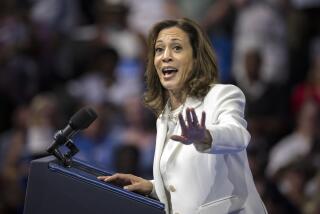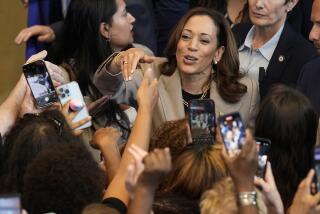Brand ‘Em, Podnuh : Harris Ranch Shifts to Selling Beef Under Its Own Label
- Share via
INTERSTATE 5 AT CALIFORNIA 198 — On the ramrod-straight, 400-mile stretch of Interstate 5 that connects the Bay Area and Los Angeles, little exists to break the tedium of the flat, seemingly endless Central Valley farmland.
About midway between the metropolises, however, one sight has given many a speeding urbanite pause: The Harris Ranch feedlot, which appears from afar to be a vast, teeming sea of black, brown and white but on closer inspection (by eye or nose) reveals itself as a motley community of 80,000 or so cattle.
Travelers probably know Harris Ranch best for its restaurant, country store and pink-and-green, hacienda-style inn, which together create a tempting oasis in the western San Joaquin Valley, at the California 198 turnoff to Coalinga.
But, increasingly, shoppers on the West Coast and even throughout the Pacific Rim are coming to identify Harris Ranch with its branded beef products, found in about 2,000 food stores and restaurants.
Selling beef under its own name, to the tune of more than $200 million last year, makes Harris Ranch a maverick in the fragmented, commodity-minded beef industry. With rare exceptions, beef produced by the nation’s major packers gets sold generically or under names devised by the big grocery chains.
At a time when red meat is viewed as a high-priced enemy of the health-conscious and beef’s market share has nose-dived, Harris Ranch hopes that putting a familiar label on its product and promoting consistent quality will help woo back customers from the ranks of chicken and fish.
About 60% of the company’s beef gets sold under the Harris Ranch label, mostly in Northern and Southern California but also, as of last year, in Portland and Seattle. The goal is 100%.
Starting in 1982, “we tried to figure out a way to differentiate our beef,” said John Harris, owner of the 20,000-acre ranch and son of the late founder, Jack Harris. “We didn’t think we could survive competing head-on” with the top processors as a commodity seller.
The industry leaders--Conagra, IBP and Excel, a Cargill subsidiary--together process about 75% of the nation’s beef. Harris Ranch, although the West Coast’s largest feeding and processing operation, ranks 52nd among the nation’s meat and poultry processors and accounts for just 1% of the nation’s beef, Harris said.
Experts in the beef industry commend Harris Ranch’s branded marketing program but note that it is a very small factor in the larger beef market and is only known on a regional basis. But the company is content, for now, to build its existing business rather than branch out.
“Harris Ranch beef clearly identified several strata of the market in California and has satisfied those well indeed,” said Steve Kay, publisher of the Cattle Buyers Weekly newsletter in Petaluma. “They are strong regionally. They haven’t sold to the big chains. They’ve sold to the small guy.”
Harris Ranch’s size could give it an edge. By being an integrated operation, it controls about 90% of its product from feedlot to delivery and therefore says it can turn out more consistent beef. That makes it more like a poultry marketer such as Foster Farms.
The company acknowledges that it’s a risky strategy, given the beef industry’s razor-thin profit margin (about 1%), the extra marketing expenses and the need for strict quality control. But Harris Ranch has managed to turn a profit, although it won’t reveal how much.
Building sales in the face of stiff consumer resistance to red meat requires attention to detail and a lot of hands-on promotion by the sales staff. Harris demonstrated as much recently in an 11-hour workday that included quick hops in the company’s Beechcraft turboprop plane to see clients in Fresno and Pismo Beach and to meet with executives at the Harris Ranch packing plant in Selma.
At the Country Boy Market in Fresno, Harris Ranch beef is displayed in a 40-foot case, with a Harris Ranch banner, posters of a mustachioed cowboy and signs promoting “Honest to Goodness Beef.”
Deliveries are made by a 50-truck fleet. For Nob Hill Foods, a family-owned grocery chain based in Gilroy, Harris Ranch delivers directly to each of 26 stores from Napa to Salinas.
“We’ve tried to become more service oriented, doing things that bigger packers can’t address,” said Dave Wood, chairman of Harris Ranch’s beef division. “We’re addressing an upper-end niche in the market.”
All of this extra care and attention costs money, of course. Harris Ranch usually charges a premium of as much as 10 cents a pound over competitors’ prices. Retailers absorb some of that cost to keep prices competitive, but consumers also pay extra.
Lynda Trelut, Nob Hill’s vice president of advertising, said the branded-beef program has paid off in the past eight years.
“It gives us something the big chains don’t have,” Trelut said. “Travelers have seen Harris Ranch for years and years. They know it’s a real place.”
At 48, John Harris scarcely fits the “Bonanza” style, preferring a four-wheel-drive Ford Explorer or the Beechcraft, which he occasionally pilots. He does wear cowboy boots, and his avocation is horses--the thoroughbred kind, which he raises for racing. Harris is one of seven stewards at the prestigious Jockey Club in Lexington, Ky.
After getting a degree in agricultural production from UC Davis, Harris began running the ranch’s diversified farming operation. In wetter times, as many as 15,000 acres are planted in cotton, almonds, asparagus, avocados, barley, wheat, melons, lettuce, onions, canning tomatoes and other crops, many of which supply the feedlot or the restaurant. Because of the drought, the crop acreage was halved this year.
The Harris Ranch restaurant, opened in 1977 and twice expanded, serves 2,000 meals a day and “has helped bring our branded program along,” Harris said. Fly-in diners use an airstrip next to the parking lot. The retail shop, which sells kitchen wares and souvenirs along with beef, has sales of more than $500,000 a year.
The 4-year-old inn, the design of which was overseen by Carole Harris, John’s wife, has grown to 123 rooms with the addition of a just-completed wing.
If the evening wind is right, guests get a strong whiff of essence of bovine, a reminder of how all this middle-of-nowhere luxury came about.
Down the road, cattle in the feedlots generally spend four months placidly growing large on a blend of grains and molasses. Multiple computers are used to keep track of feed and weight gain. The animals are slaughtered at 1,075 pounds or so (down from an average of 1,125 pounds eight years ago, before customers began clamoring for leaner beef).
In the northeast corner, a few dozen beasts live a slightly more pampered existence, finding shade from the blistering Central Valley sun under a crude ceiling made of slats. Part Angus and part Japanese wagyu , they were bred with some rare wagyu semen left over from a long-ago Colorado State University experiment.
These cattle represent a key element of Harris Ranch’s campaign to court the growing market in Japan, where especially tender beef “marbled” heavily with fat brings as much as $100 a pound.
Harris Ranch executives have traveled often to Japan since 1984 in an effort to build relationships and learn what suits the Japanese palate. The ranch sends about 5% of its highest-quality beef to upscale department and food stores in Japan, where it is displayed along with cowboy hats and the U.S. flag.
Unfortunately, the current high tariff of 70%, which the Japanese imposed in April when they dropped import quotas, puts Harris Ranch’s premium product at a disadvantage.
“The high duty in Japan may hurt our business this year,” said John Isadore, senior vice president in charge of overseas sales. “The industry is kind of hanging their hat on the Pacific Rim. I think they’re a little overly optimistic.”
In the meantime, Harris Ranch executives realize that their biggest challenge is winning over U.S. customers who have forsaken beef. John Harris sprinkles his conversation with statistics about fat content and calories that show beef in a favorable light.
To critics of red meat, he has a matter-of-fact response: “We think beef should be viewed as a health attribute rather than a negative.”
Hold the Beef? U.S. per capita consumption of beef has been on the decline since 1986, largely because of health concerns, but also in part because the national beef herd has been shrinking as the human population has grown. Average Annual U.S. Per Capita Consumption of Beef and Veal (boneless weight in pounds) 1980 to 1990
The National Herd Total Cattle and Calves in U.S. (in millions) 1980 to 1990 Source: USDA
Where’s the Beef? U.S. beef exports, particularly to the Pacific Rim, have been on an upswing in recent years but still account for only 5% of U.S. beef. Japan, the largest market for U.S. beef, imported nearly $1 billion worth in 1990, about 60% of the total. With trade barriers coming down, the Japanese market is expected to double by the end of the ‘90s, especially given the current low level of beef consumption: about 14 pounds per capita compared to about 64 pounds in the United States. U.S. Exports of Beef and Veal (billions of dollars) 1981 to 1990 Source: U.S. Department of Agriculture
More to Read
Inside the business of entertainment
The Wide Shot brings you news, analysis and insights on everything from streaming wars to production — and what it all means for the future.
You may occasionally receive promotional content from the Los Angeles Times.









